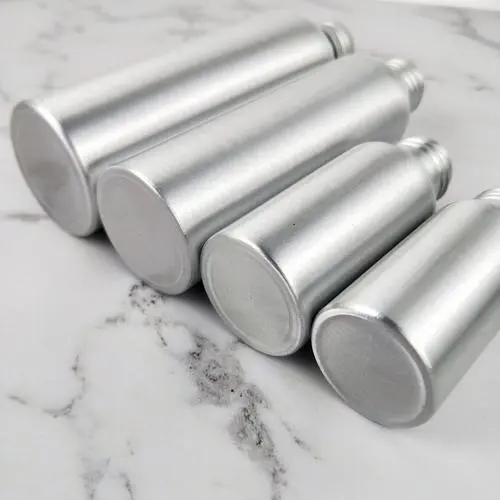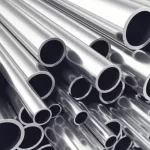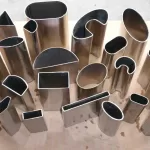Aluminum is one of the most common metals used in the world today. It has several desirable properties such as: excellent strength, ductility, strength-to-weight ratio, and corrosion resistance. While aluminum and its various salts and oxides have been used since the time of the Roman Empire, the metal was not formally discovered until 1808, by Humphry Davy, and was not refined and mass-produced as known today until 1888. Today, aluminum is used in a wide range of applications and industries including: soda cans, kitchen foil, aircraft fuselage, and automobile frames. This article will define aluminum, review its history, describe its characteristics and properties, and discuss different applications of this highly versatile metal.
Learn more about this material in detail and its various applications in manufacturing.
Welding Town
What Is Aluminum?
Aluminum is a silvery-white, lightweight, corrosion-resistant, non-magnetic, and ductile material. It is the most abundant metal on Earth. It makes up more than 8% of the matter in Earth’s crust, behind only oxygen and silicon. Aluminum is the most produced and refined non-ferrous metal because of its properties and abundance. It is commonly used in a number of industries, including transportation, construction, packaging, machine manufacturing, and consumer goods.
What Is the History of Aluminum?
While aluminum has been used for centuries, humanity was largely unaware of the metal, since it is seldom found in its pure form. It is often found in rocks, minerals, and, clays. From ancient times up until the Industrial Revolution, alum, an aluminum-based salt, was the most common form in which aluminum was used. It was often used as a flame-retardant, in dyes and medicines, and in pottery.
In 1807, Humphry Davy described the existence of an unknown metal in alum and unsuccessfully attempted to isolate it through electrolysis. In 1825, Hans Christian Ørsted successfully isolated aluminum by reduction of aluminum chloride. In 1854, Henri Sainte-Claire Deville further advanced the aluminum reduction process to produce higher quantities of metal. In 1886, Charles Martin Hall and Paul Louis Toussaint Héroult simultaneously developed the smelting process for aluminum which is still used today. As a result of the availability of the more efficient refinement process, aluminum use exploded in the 20th century.
What Is the Symbol for Aluminum?
The symbol for aluminum on the periodic table is “Al.”
What Is the Atomic Number of Aluminum?
The atomic number of aluminum is 13. It is the first post-transition metal on the periodic table. Aluminum is in the 3rd period (row) and in the 13th group (column).
What Is the Atomic Weight of Aluminum?
The atomic weight of aluminum is 26.98 amu (atomic mass units). 1 amu is equivalent to 1/12th the size of a neutral carbon atom.
What Is the Other Term for Aluminum?
Another term for aluminum is “aluminium.” While “aluminum” is commonly used in the United States and Canada, “aluminium” is often used in the rest of the English-speaking world. The American Chemical Society (ACS) adopted “aluminum” as the official term for the element in 1925, but the International Union of Pure and Applied Chemistry (IUPAC) adopted “aluminium” as the official term in 1990.
What Is Aluminum Made Of?
Aluminum is found in nature as alum (sulfate) forms and oxides. Materials from which pure aluminum can be refined are listed below:
- Bauxite
- Clay
- Shale
- Slate
- Granite
- Anorthosite
What Are the Characteristics of Aluminum?
Some of the aluminum’s main characteristics are described below:
- It is lightweight, with a density about one-third that of steel.
- It has a high strength-to-weight ratio.
- It is naturally corrosion-resistant due to the formation of a tightly adherent oxide layer on its surface.
- It is highly ductile.
- It has a lustrous, silvery-white color.
- It has excellent thermal and electrical conductivity.
What Is the Color of Aluminum?
Pure aluminum, aluminum alloys, and treated aluminum all have a silvery-white color.
What Does Aluminum Look Like?
An example of pure aluminum is shown in Figure 1 below:
In nature, aluminum most often appears in the form of oxides in bauxite ore. The appearance of bauxite is a tan, reddish rock that has a dull luster and resembles clay. After bauxite ore is refined and processed, pure aluminum looks similar to the image above. It is a silvery-white, lustrous material.
What Is the Density of Aluminum?
The density of aluminum is 2.71 g/cm3.
What Are the Different Types of Aluminum?
The different types of aluminum are described below:
1. Pure Aluminum
Pure aluminum contains no alloying elements and low levels of contaminants. It almost never occurs in nature and is obtained by refining mined minerals and ores, such as bauxite. It is soft, ductile, corrosion-resistant, and electrically conductive. Pure aluminum is often used for non-loadbearing applications such as wires, cables, and foil.
2. Aluminum Alloys
An aluminum alloy is a material composed of pure aluminum and alloying elements. The additional elements in the structure of pure aluminum make aluminum stronger. Aluminum alloys are made by melting and mixing pure aluminum with the alloying element(s) and allowing the mixture to cool. Aluminum alloys are harder and stronger than pure aluminum but are still lightweight, ductile, corrosion-resistant, and electrically conductive. Aluminum alloys are often used to make automotive engines and chassis, airplane wings, and consumer products.
3. Cast Aluminum
Cast aluminum products are made from aluminum alloys that are melted and then poured into molds to create the final shapes. Casting aluminum is a cost-effective way to produce large quantities of parts. However, cast aluminum parts have lower tensile strength and lower ductility than wrought aluminum parts. Casting is used for engine components and prosthetic parts.
4. Wrought Aluminum
Wrought aluminum and aluminum alloys are shaped using forming processes such as aluminum extrusion, rolling, or forging. These processes are used to form billets, rods, and ingots for other manufacturing processes such as machining. It is used for machining and sheet metal fabrication processes to make parts for the automotive, aerospace, medical, and consumer product industries.
5. Anodized Aluminum
Anodized aluminum is aluminum or an aluminum alloy whose surface has been made harder and more durable through electrochemical reactions. Anodizing can also be used to create different-colored surfaces with a matte or lustrous finish. Anodized aluminum is often used in: construction and architectural products like window frames and signage; interior components on airplanes and trains; and attractive surfaces for consumer products like electronics and kitchen appliances.
6. Clad Aluminum
Clad aluminum, also known as Alclad, is an aluminum alloy made by covering additional layers of pure aluminum or an aluminum alloy onto an aluminum alloy substrate to further improve its corrosion resistance. The clad aluminum alloy is anodic and electrochemically protects the substrate against corrosion. Alclad is commonly used in aerospace applications and is made by rolling the alloy onto the substrate and heating the composite material to high temperatures.
What Type of Metal Is Aluminum?
Aluminum is a post-transition metal in group 13, or the Boron group, of the periodic table. It tends to form chemical compounds with a +3 oxidation state due to its +3 cation. This makes aluminum bond readily with other elements, primarily oxygen, and any anion offering a -3 state.
What Are the Properties of Aluminum?
Aluminum has several desirable physical and chemical properties, including good electrical and thermal conductivity. Its notable physical and chemical properties are shown in Tables 1 and 2 below:
What Are the Physical Properties of Aluminum?
The physical properties of aluminum are described in Table 1 below:
Table 1: Physical Properties of Aluminum
| Property | Definition | Example | Units | Importance |
|---|---|---|---|---|
| Density | The mass of material per unit volume | 2.71 g/cm3 | g/cm3 | Lightweight material with a high strength-to-weight ratio. |
| Strength | The ability of a material to withstand a load. | 80 MPa (AA1050A 0) to 570 MPa (AA7075 T6) | MPa or psi | Has high strength given its low weight, which allows it to be used in several load-bearing applications. |
| Color | The wavelength of light reflected by a material | Lustrous, silver-white color | N/A | Appealing appearance for various consumer products and structures. |
| Ductility | The ability of a material to bend or stretch before fracturing. | Highly ductile | Unitless. Total percent elongation after a tensile test | Absorbs energy as plastic deformation before fracture, easily formed. |
What Are the Chemical Properties of Aluminum?
The chemical properties of aluminum are described in Table 2 below:
Table 2: Chemical Properties of Aluminum
| Property | Definition | Example | Importance |
|---|---|---|---|
| Oxidation potential | A reaction, typically with air. | Aluminum oxides in bauxite. | Readily reacts with air and are typically found in nature as oxides. |
| Ability to form alloys | Ease of forming alloys with aluminum. | Several hundreds of different aluminum alloys exist. | Allow desired physical and mechanical properties to be obtained that are not present in pure aluminum. |
| Reactivity | Ability to form aqueous and mutual solutions with other materials. | Aluminum reacts with mineral acids and alkalis to make aqueous solutions. | Aluminum acids like aluminum hydroxide are commonly used as a fire retardant and in pharmaceuticals. Aluminum bases are commonly used in water treatment and accelerating concrete curing. |
| Corrosion resistance | A material’s ability to resist degradation due to corrosion | Commonly found as aluminum oxide in nature which makes it naturally corrosion resistant. | Its natural corrosion resistance allows aluminum and its alloys to be used in a wide range of environments. |
What Are the Applications of Aluminum?
The applications of aluminum in various industries are described below:
1. Transportation
Aluminum is used in the automotive, aerospace, and marine industries due to its lightweight and high strength-to-weight ratio. It is used for vehicle bodies, engine components, and wheels to reduce weight and improve fuel efficiency. Aluminum is used for structural components in aircraft, such as wings and fuselage, to reduce weight and improve aerodynamics. It is used for hulls, masts, and other ship components due to its corrosion resistance in saltwater environments.
2. Packaging
Aluminum is used in consumer packaging due to its recyclability, lightweight, and corrosion resistance. It is often used for beverage cans and drug packaging.
3. Construction
Aluminum is used in construction due to its strength, ductility, and corrosion resistance. It is regularly used in structures such as homes, high-rise buildings, and bridges. Its light weight makes its use in construction easy, efficient, and cost-effective. Aluminum helps reduce the overall weight of a structure which leads to reduced costs associated with foundations.
4. Electrical Appliances
Aluminum is often used in electrical appliances due to its lightweight and good electrical conductivity. It is often used in motors, TV antennas, appliances, and satellite dishes. Aluminum is also often used for power lines where its lightweight, ductility, and corrosion resistance make the material ideal.
5. Consumer Goods
Aluminum’s silvery, sleek appearance, as well as its durability, lightweight, and excellent thermal conductivity make the material a good choice for use in consumer goods. Aluminum is used as a case for smartphones, TVs, and laptops because of its lightweight, appearance, and ability to keep devices from overheating. It is also often used in cookware due to its corrosion resistance, lightweight, and thermal conductivity, which promotes even heating.
6. Machinery and Equipment
Aluminum is often used in machinery and equipment due to its lightweight, high strength-to-weight ratio, and corrosion resistance. It is used to build frames and motion control mechanisms for industrial machinery and equipment. It’s also often used for sensors, conveyors, and other industrial components.
7. Medical Equipment
Aluminum is used in medical equipment such as wheelchairs, walkers, and crutches due to its light weight and strength. It is also used for surgical instruments and implants due to its biocompatibility and resistance to corrosion in the body.
What Are the Benefits of Aluminum?
The benefits of aluminum are listed below:
- It is a lightweight material and has a density (2.71 g/cm3) of about one-third that of steel. It is useful in applications where reduced weight is favored, such as in the automotive or aerospace industries.
- Aluminum is highly corrosion resistant due to the natural formation of a protective oxide layer on its surface. It can withstand a broad spectrum of environmental conditions in industries such as transportation, construction, and consumer goods.
What Are the Limitations of Aluminum?
The limitations of aluminum are listed below:
- Although aluminum is a strong metal, its strength is generally lower than that of steel.
- It is more expensive than materials such as steel or plastic. The price of the raw materials and the energy needed to produce aluminum and aluminum alloys both contribute to the high price of aluminum.
- Aluminum has high thermal conductivity. This makes welding aluminum difficult since welds solidify much faster on aluminum than on steel.
Is Aluminum Lightweight?
Yes, aluminum is lightweight. The density of aluminum is 2.71 g/cm3, about one-third that of steel.
Is Aluminum Durable?
Yes, aluminum is durable. Aluminum is used in a wide range of applications, such as in packaging, construction, and transportation.
Is Aluminum Functional?
Yes, aluminum is functional. It is lightweight, strong, durable, and a good conductor of heat and electricity.
Is Aluminum a Metal?
Yes, aluminum is metal. It is considered a metal because it is a good conductor of heat and electricity, has a lustrous appearance, and readily loses electrons to form positive ions (cations).










